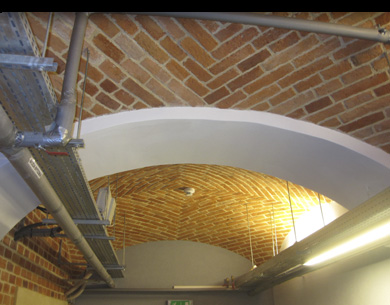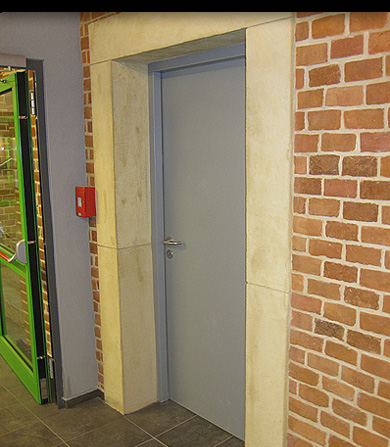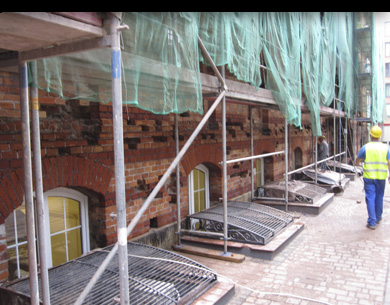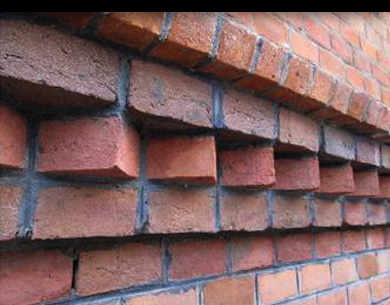Rehabilitated vaults:
The renovation plaster was integrated in an optically
skilled way into the brickface.

In the basements as well
as on the ground floor large areas of the masonry were
damaged by salt and showed a particularly high concentration
of nitrate.

The brick facades were
heavily damaged by environmental influences.

Thanks to the sandstone rehabilitation system S3 the
door
portals are now again in an optimal condition.

During the rehabilitation.

Larger fragments were
restored with brick rehabilitation mortar.

|
|
|
Brick
rehabilitation on the construction site
Tadeusz Kosciuszko University of Kraków, Poland

Ammerbuch, February 2013. Currently,
around 17 buildings of the Tadeusz Kosciuszko University of Technology
in the Polish Kraków are being rehabilitated. By doing so,
the special building material systems for rehabilitation of brick
and masonry of the epasit company from the Swabian Ammerbuch, prove
their worth.
Owners of historical brick buildings, curators of monuments and
masons in the entire world have to decide on how to restore historical
buildings in the correct way. The brick rehabilitation system offers
you a permanent and effective solution, because its components are
exactly harmonized and can be easily applied.
Former barracks in a delapidated condition

In 2009, the rehabilitation of further sections
of the Institute of Technology of Kraków in Southern Poland,
has been decided. The building constructed between 1872 and 1878
has been used for a long time by the Polish and Russian army and
the structure suffered for decades. In the basements, as well as
on the ground floor, large areas of the masonry were damaged by
salt and showed a particularly high concentration of nitrate. For
a long time, the finishes of the interior walls have been destroyed
by salts and brick facades and brick walls have been heavily damaged
by environmental influences.
Rehabilitation of the
interiors

In spring 2010, the dismantling works started and all ailing finishes
of interior walls were removed. Because the salination extended
deeply into the masonry, the responsible persons opted for a rehabilitation
using a plaster system which withstands special stress. It meets
all requirements of the preservation of monuments as well as of
the DIN EN 998-1 and was awarded as the first renovation plaster
system the WTA certificate. For the construction of the walls, special
plasters such as 'MineralDicht sperr' and '5in1' as well as the
rehabilitation system 'Mineral SanoPro' from epasit was used.
Brick facades get rehabilitated

In the years 2011 and 2012 the masons mainly
devoted themselves to the restoration of the brick facades. Because
of the aggressive environmental pollution in the Polish coal-mining
district these have been massively damaged. The masons tried to
remove the worst damages by exchanging the bricks, which, however,
turned out to be very complex and expensive. Further, based on the
motto 'restore instead of replace' the brick rehabilitation system
ZRS was convincing. In the end, the skilful combination of the existing
substance and replenishments appear much more natural. It gives
the brick walls of the Institute of Technology of Kraków
a fresh new look and preserves at the same time the original character.
Brick rehabilitation: System
application instead of isolated application

Firstly, all surfaces were cleaned mechanically
in order to remove all disintegrated particles and undermined joints
have been raked out. Secondly, the masons saturated the bricks with
the mineral hardener 'sv', with which the stone structure of the
upper layer could be restabilised. Larger fragments have been remodelled
with brick rehabilitation mortar mixed in the original colour. The
thoroughly cleaned joints were filled by the masons with the rehabilitation
pointing mortar 'fsm', which was also coloured according to the
sample. Finally, the outer facade surfaces were permanently protected
from rain and environmental influences with the waterproofing 'ip237'.
Fragments on door frames rehabilitated

The door portals and frames in the interior
of the buildings, too, were partly affected by disintegration. The
missing structure was replaced by components of the sandstone rehabilitation
system S3 from epasit, which were adapted in colour and structure
to the original. For this, the portals in question have firstly
been cleaned. Secondly, the masons coated them with a bonding slurry
which is easy to apply. The fine sandstone rehabilitation mortar
was mixed with 'fx Fixal' and applied on the still wet bonding slurry.
Thanks to the system S3 the door portals are now again in an optimal
condition.
Brick vaults

In the basement rooms and corridors of the
Tadeusz Kosciuszko University of Technology in Kraków, extensive
brick surfaces had to be rehabilitated as well. On surfaces especially
affected by salt, the long-term proven renovation plaster, 'MineralSanoPro'
was applied and integrated in an optically skilled way into the
brickface. After rehabilitation, the basement rooms will be utilised
as offices, laboratories, server and storage rooms as well as a
cafeteria. This utilization requires a high standard regarding room
temperatures, humidity of the air and healthy climate. In this case
the mineral calcium silicate boards 'epatherm' and the climatic
plaster 'ekp' have been used, so that the relative humidity of the
air levelled out at a constant standard of approx. 60 per cent even
without an expensive primary energy - a cost-effective and nonpolluting
solution.
Presscontact:
epasit GmbH Spezialbaustoffe
Peggy Wandel
Sandweg 12 - 14, D-72119 Ammerbuch-Altingen,
Tel +49 (0) 7032 2015-0, Fax +49 (0) 7032 2015-21
e-Mail: presse@epasit.de
|
|

FURTHER OBJECTS:

Gymnasium zu Bratislava

Burg zu Bratislava

Trinkwasserbehälter
Lindau

Altes Rathaus
Bonn

Stadtgymnasium
Helsinki
 Jugendstilvilla
in Aalen
Jugendstilvilla
in Aalen
 Waldseer
Hof Markdorf
Waldseer
Hof Markdorf
 Therme
Rügen
Therme
Rügen

Schimmelalarm im
Badezimmer

Diakonie-Gebäude
Witten

Leonhardskirche English
>>

Deutscher Kaiser
English
>>

Wilhelma Stuttgart English
>>

Trinkwasserbehälter English
>>

Hafenviertel Tallinn English
>>

EZB Frankfurt English
>>

Zwinger Dresden English
>>

TU-Krakau English
>>

Brunnen Maulbronn English
>>

Jurahaus English
>>

Contact
us

Do you have questions and need
a personal contact?
Phone
+49 (0)7032
- 20 15-0
Project management

Martin Hirsch

If you have further questions regarding this object or a similar
problem, please contact us.
Contact us

e-Mail:
sales@epasit.eu
Phone:
07032-2015-281
|